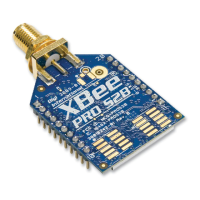XBee ZigBee networks Coordinator operation
XBee/XBee-PRO ZigBee RF Modules User Guide 40
If any of the command values in the network formation commands table changes, the coordinator will leave its
current network and start a new network, possibly on a different channel. Note that command changes must be
applied (AC or CN command) before taking effect.
Permit joining
The permit joining attribute on the coordinator is configurable with the NJ command. NJ can be configured to
always allow joining, or to allow joining for a short time.
Joining always enabled
If NJ=0xFF (default), joining is permanently enabled. This mode should be used carefully. Once a network has
been deployed, the application should strongly consider disabling joining to prevent unwanted joins from
occurring.
Joining temporarily enabled
If NJ < 0xFF, joining will be enabled only for a number of seconds, based on the NJ parameter. The timer is started
once the XBee joins a network. Joining will not be re-enabled if the module is power cycled or reset. The
following mechanisms can restart the permit-joining timer:
Changing NJ to a different value (and applying changes with the AC or CN commands)
Pressing the commissioning button twice (enables joining for one minute)
Issuing the CB command with a parameter of two (software emulation of a two button press - enables joining
for one minute)
Resetting the Coordinator
When the coordinator is reset or power cycled, it checks its PAN ID, operating channel and stack profile against
the network configuration settings (ID, CH, ZS). It also verifies the saved security policy against the security
configuration settings (EE, NK, KY). If the coordinator's PAN ID, operating channel, stack profile, or security policy
is not valid based on its network and security configuration settings, then the coordinator will leave the network
and attempt to form a new network based on its network formation command values.
To prevent the coordinator from leaving an existing network, the WR command should be issued after all
network formation commands have been configured in order to retain these settings through power cycle or
reset events.
Leaving a network
There are a couple of mechanisms that will cause the coordinator to leave its current PAN and start a new
network based on its network formation parameter values. These include the following:
Change the ID command such that the current 64-bit PAN ID is invalid
Change the SC command such that the current channel (CH) is not included in the channel mask
Change the ZS or any of the security command values (excluding NK)
Issue the NR0 command to cause the coordinator to leave
Issue the NR1 command to send a broadcast transmission, causing all devices in the network to leave and
migrate to a different channel
Press the commissioning button four times or issue the CB command with a parameter of 4
Issue a network leave command
Note that changes to ID, SC, ZS, and security command values only take effect when changes are applied (AC or
CN commands).

